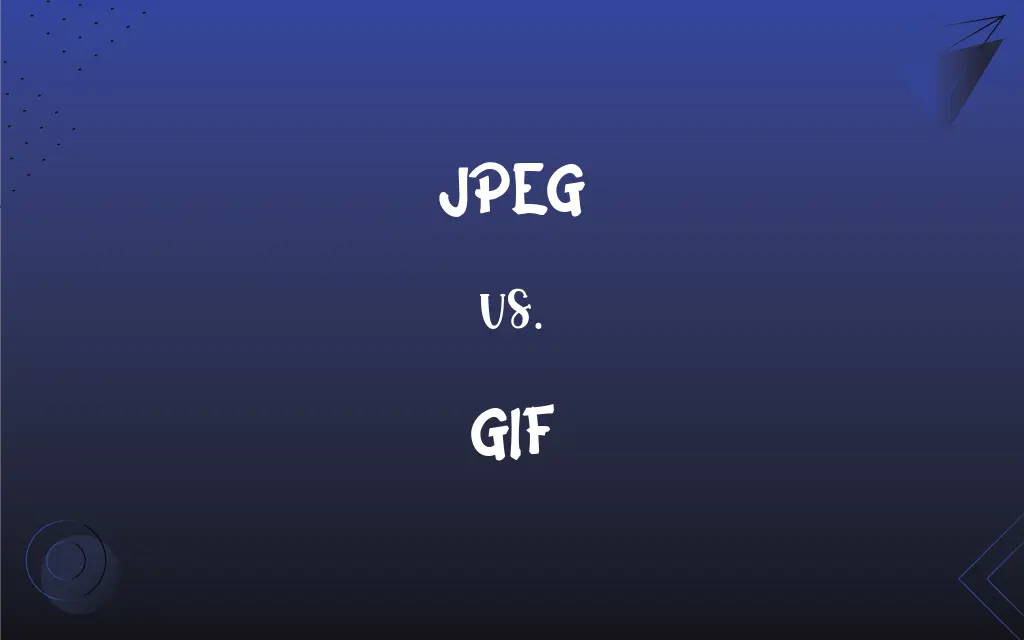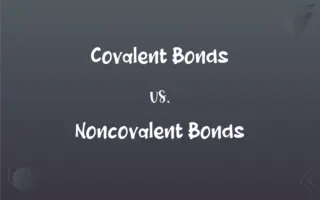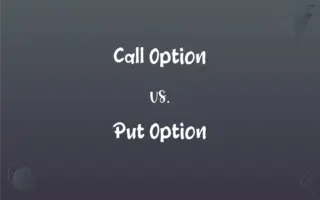JPEG vs. GIF: What's the Difference?
Edited by Aimie Carlson || By Janet White || Published on February 6, 2024
JPEG (Joint Photographic Experts Group) is for complex, high-quality images with color depth; GIF (Graphics Interchange Format) supports animations and simple images with limited colors.

Key Differences
JPEG, a format developed by the Joint Photographic Experts Group, is optimal for complex images like photographs due to its support for millions of colors and its lossy compression, which efficiently reduces file size while maintaining visual quality. GIF, standing for Graphics Interchange Format, is better suited for simpler images with fewer colors, like logos or graphics with up to 256 colors, making it less ideal for detailed photographs.
JPEG does not support animation and offers no transparency options, making it solely for static images. GIF, on the other hand, is well-known for its ability to support simple animations, looping a series of images, and it can handle transparency, though only one color can be transparent, limiting its versatility.
Due to its lossy compression, JPEG images usually have smaller file sizes, suitable for websites where loading speed is crucial. GIF uses lossless compression, which doesn’t degrade image quality but results in larger file sizes, especially for images with many colors or detailed animations.
JPEG is widely used in digital photography and online content, where high-resolution images are needed. GIFs are commonly used for simple web graphics, small animations like emoticons, or banners where file size isn't a major concern but simplicity and small color palettes are.
JPEG can display over 16 million colors, making it ideal for full-color photographs and complex gradients. GIF is limited to a 256-color palette, which can lead to a noticeable reduction in color depth and image fidelity, especially in more detailed images.
ADVERTISEMENT
Comparison Chart
Color Depth
Supports over 16 million colors, ideal for complex images
Limited to 256 colors, suitable for simpler graphics
Image Quality
Uses lossy compression, reducing file size with quality loss
Employs lossless compression, maintaining original quality
Animation Support
Does not support animations
Supports simple animations
Transparency
Lacks transparency features
Supports single-color transparency
Ideal Use
Best for photographs and detailed images
Suitable for simple graphics, logos, and small animations
ADVERTISEMENT
JPEG and GIF Definitions
JPEG
JPEG is widely used for storing and transmitting photographic images.
Most of the images on the website are in JPEG format for efficiency.
GIF
GIF uses lossless compression, suitable for simple graphics.
For the logo design, a GIF was used to preserve sharp lines and colors.
JPEG
JPEG is a digital image format with lossy compression.
The photographer saved the photo as a JPEG to reduce the file size.
GIF
GIF is a bitmap image format supporting animations and transparency.
The website's banner was a looping animation saved as a GIF.
JPEG
JPEG format is preferred for its balance of quality and file size.
He chose JPEG for his portfolio to ensure quick loading times without losing quality.
GIF
GIF format is popular for small animations and internet memes.
She shared a humorous GIF on social media.
JPEG
JPEG is common in digital cameras and online platforms.
Social media platforms often compress uploaded images to JPEG for faster display.
GIF
GIF can display transparent backgrounds, useful for web graphics.
The GIF icon was placed over the website's background seamlessly due to its transparency.
JPEG
JPEG supports millions of colors, making it suitable for complex images.
The JPEG image perfectly captured the vibrant colors of the sunset.
GIF
GIF is limited to a 256-color palette, ideal for less complex images.
The cartoon was converted into a GIF, maintaining its basic color scheme.
JPEG
A standard algorithm for the compression of digital images.
GIF
A raster-based format for storing files of color graphics.
JPEG
A digital image stored as a file so compressed
A JPEG of a cat.
GIF
An image or animated clip recorded in such a format.
JPEG
Alternative case form of JPEG
GIF
Alternative case form of GIF
JPEG
A standardized format for storing graphic data in binary computer files, allowing over 16 million different colors. It allows for lossy compression, i. e. the compression of data into a form which re-expands into an image close, but not identical to the original image. Files stored in this format usually carry the extension jpg or jpeg. Compare GIF.
GIF
Alternative case form of GIF
GIF
If.
GIF
The Graphics Interchange Format, one of the most popular standardized formats for storing graphic data in binary computer files. The standard has been revised several times, and includes provisions for interlacing and animating images. Its disadvantage is that it can store only 256 colors. Compare JPEG.
GIF
An image stored in GIF{1} format, or the file in which the image is stored; as, he sent three GIF's with lovely pictures of his children.
FAQs
What does JPEG stand for?
JPEG stands for Joint Photographic Experts Group, the name of the committee that created the standard.
Does GIF support full color depth?
No, GIF is limited to 256 colors.
Can JPEG images be animated?
No, JPEG images cannot be animated; they are static.
Can GIF display transparent backgrounds?
Yes, GIF can display one color as transparent.
Is JPEG suitable for web graphics?
Yes, JPEG is suitable for web graphics, especially for photographs and detailed images.
Is JPEG good for printing photos?
Yes, JPEG is often used for printing photos due to its high color fidelity.
What is GIF best used for?
GIF is best used for simple graphics, animations, and images with limited color palettes.
Why is GIF popular for memes?
GIF is popular for memes due to its support for simple animations and wide compatibility.
Why is GIF not ideal for photographs?
GIF is not ideal for photographs due to its limited color palette.
How does JPEG compression affect image quality?
JPEG’s lossy compression reduces file size but can lead to a loss in image quality, especially at higher compression levels.
Are JPEG images lossless?
No, JPEG images use lossy compression.
Is GIF suitable for detailed graphics?
No, GIF is not suitable for detailed graphics due to its color limitations.
Why do JPEG images lose quality?
JPEG images lose quality due to lossy compression, which reduces file size by discarding some image data.
Can JPEG images have a small file size?
Yes, JPEG images can have a small file size due to their efficient compression.
How do GIF animations work?
GIF animations work by looping a series of images to create a moving picture.
Can JPEG support transparency?
No, JPEG does not support transparency.
Can GIF be used for video?
GIF can be used for short, simple video clips but is not suitable for longer or high-quality videos.
What’s the main advantage of GIF over JPEG?
The main advantage of GIF over JPEG is its support for animations and transparency.
What format should be used for high-quality print images, JPEG or GIF?
JPEG should be used for high-quality print images due to its superior color depth and image fidelity.
Is JPEG or GIF better for online use?
It depends on the use case; JPEG is better for detailed images, while GIF is better for simple animations and graphics.
About Author
Written by
Janet WhiteJanet White has been an esteemed writer and blogger for Difference Wiki. Holding a Master's degree in Science and Medical Journalism from the prestigious Boston University, she has consistently demonstrated her expertise and passion for her field. When she's not immersed in her work, Janet relishes her time exercising, delving into a good book, and cherishing moments with friends and family.
Edited by
Aimie CarlsonAimie Carlson, holding a master's degree in English literature, is a fervent English language enthusiast. She lends her writing talents to Difference Wiki, a prominent website that specializes in comparisons, offering readers insightful analyses that both captivate and inform.







































































